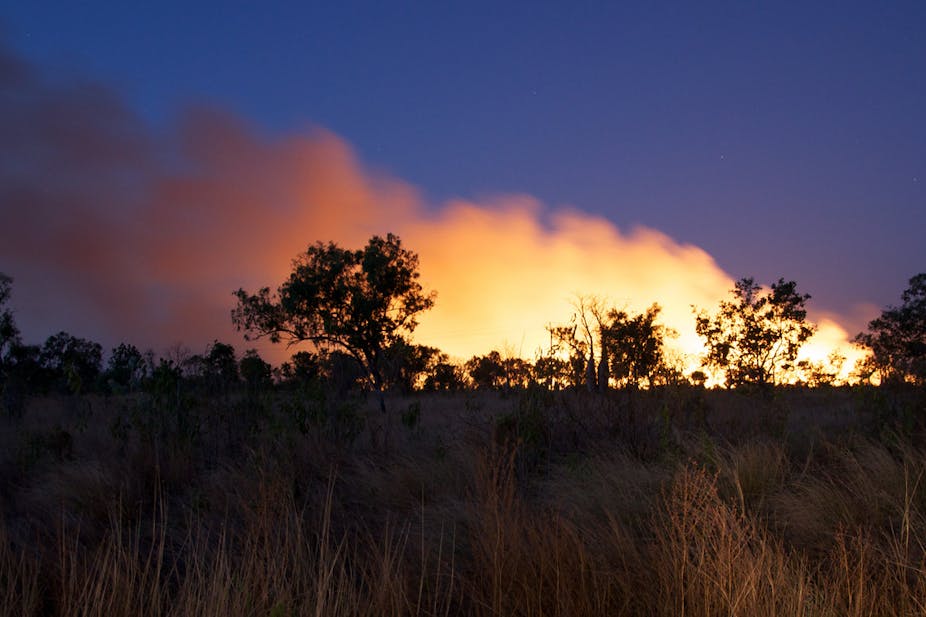For thousands of years, Aboriginal Australians burned forests to promote grasslands for hunting and other purposes. Recent research suggests that these burning practices also affected the timing and intensity of the Australian summer monsoon.
It is perhaps difficult for some of us to imagine that a single species, Homo sapiens, can affect the Earth’s climate system. But a cursory view of satellite images of the Earth emphasises the scale of the environmental changes that we have brought about. Most of us are aware of our contribution to the pollution of the Earth’s atmosphere, rivers and oceans; to severe land degradation, salinity, and so on.
During the last few decades, human-induced climate change has been a pervasive theme in the scientific literature. Central to the concept is the role of greenhouse gas added to the atmosphere during the industrial era.
Lesser-known is the idea championed by Bill Ruddiman. This describes the role early farming played in climate change during the last several thousand years through land clearing, raising livestock, and irrigating rice paddies. Ruddiman’s research, while not without its critics, suggests that these resultant climatic changes set the Earth on a different, unnatural climate path.
Ruddiman’s findings led to the “early anthropogenic hypothesis”. This is the idea that early agriculturalists caused an anomalous reversal in natural declines of atmospheric carbon dioxide 7,000 years ago and methane about 5,000 years ago.
As long ago as 1975, Jules Charney recognised climate feedbacks caused by land-surface modifications. He showed that vegetation clearing, overgrazing and burning may have had an impact on the devastating drought experiences of semi-arid areas such as the Sahel region of West Africa.
Additionally, it is well known that different vegetation types can alter evaporation, roughness, and surface reflectivity, leading to changes in the weather and climate.
The Australian scene
Europeans’ impact on the Australian environment exemplifies the role of human modifications on the Earth’s land-surface. Tom Lyons’ “bunny fence” experiments have drawn attention to likely climate impacts and feedbacks Europeans may have caused. “Clearing the woodland” has been part of the European historical environmental geography literature for a long time.
Pre-historians and ecologists have been long concerned with the possible effect that Aboriginal vegetation burning practices may have had on the Australian ecology. Bill Gammage has recently published a very readable overview of the concept in “The biggest estate on Earth: how Aborigines made Australia”.
Vegetation burning remains a pervasive theme in Australian prehistory, but what impact has it had on the climate regime of the continent? An answer to this question can be found in two ways.
We can investigate the archives of vegetation changes associated with charcoal, recorded in geological sequences. Or we can take a more direct approach and use elements of the suite of climate models that are now available. For the Australian scene, previous climate model experiments have indicated a likely climatic response to changes in vegetation cover.
More recently, our research group, consisting of members from The University of Western Australia and the University of Wisconsin-Madison, approached this theme through a comprehensive modeling effort using a global scale coupled ocean-atmosphere model. As part of a wider study of the climate history of the northwest Australian monsoon region, funded in part by Kimberley Foundation Australia, we posed the direct question: “Did Aboriginal vegetation burning practices impact on the function of the northwest Australian summer monsoon?”
We showed that the climate responded significantly to reduced vegetation cover in the pre-monsoon season. We found decreases in rainfall, higher surface and ground temperatures and enhanced atmospheric stability. In other words, there was a decline in the strength of the early monsoon “phase”.
The results of the experiment lead us to suggest that by burning forests in northwestern Australia, Aboriginals altered the local climate. They effectively extended the dry season and delayed the start of the monsoon season.
More than anything else, our results are a further reminder, if needed, of the sensitivity of the global climate system.

